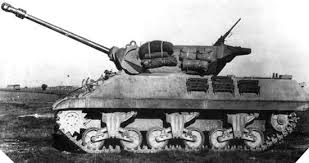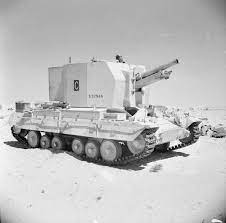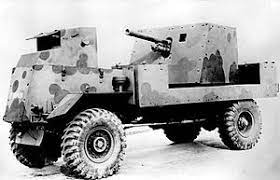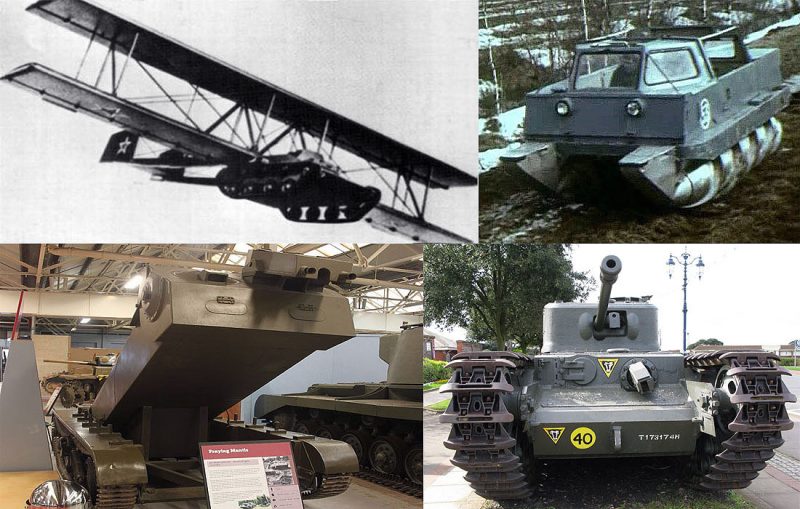The next vehicle is a tank destroyer and a modification of an American vehicle. This is the Achilles. It was one of the first vehicles to use a 17-pounder gun, which replaced the 3-inch gun on its base design, the American M10 tank destroyer. This was used as almost a replacement for anti-tank guns. By this, I mean that it would be used defensively instead of having to prepare a 17-pounder AT gun for what could take up to a day. This gave defenses more flexibility with the same firepower but more time to prepare. It had a light amount of armor: only between around 9 and 59 millimeters of welded steel for protection.
 This gave it a good resistance to lighter AT guns and rifles, but a German 88 mm could tear it apart, or some of the smaller-caliber guns if it got unlucky. It also was open-topped until a roof was fitted on in later designs, but in the earlier ones this made it very vulnerable to top attacks such as strafing runs, artillery, or bombs. [Ed. Note—because what every military wants is a convertible-style tank. Genius.] It did have secondary weapons, mounting either a .50 caliber 12.7 mm Browning machine gun or a 7.62 mm Bren gun. This gave it very good close support abilities, since the main gun had to focus on armored threats. The vehicle was able to use a high explosive shell, which was good but was quite redundant due to this being a tank destroyer, although it was quite a good shell for the time. The vehicle was manned by a group of five men, consisting of a commander, a loader, a gunner, a driver, and a loader’s assistant. It was used mostly in Europe during Operation Overlord and the Italian campaign, where it proved to be very effective, destroying many armored vehicles, including many of the German big cats. It was quite reliable and did not have any major mechanical problems, mostly due to the stress on its engine remaining quite low due to the light armor load decreasing weight. Due to its good all-around design it was a very reliable and overall good vehicle.
This gave it a good resistance to lighter AT guns and rifles, but a German 88 mm could tear it apart, or some of the smaller-caliber guns if it got unlucky. It also was open-topped until a roof was fitted on in later designs, but in the earlier ones this made it very vulnerable to top attacks such as strafing runs, artillery, or bombs. [Ed. Note—because what every military wants is a convertible-style tank. Genius.] It did have secondary weapons, mounting either a .50 caliber 12.7 mm Browning machine gun or a 7.62 mm Bren gun. This gave it very good close support abilities, since the main gun had to focus on armored threats. The vehicle was able to use a high explosive shell, which was good but was quite redundant due to this being a tank destroyer, although it was quite a good shell for the time. The vehicle was manned by a group of five men, consisting of a commander, a loader, a gunner, a driver, and a loader’s assistant. It was used mostly in Europe during Operation Overlord and the Italian campaign, where it proved to be very effective, destroying many armored vehicles, including many of the German big cats. It was quite reliable and did not have any major mechanical problems, mostly due to the stress on its engine remaining quite low due to the light armor load decreasing weight. Due to its good all-around design it was a very reliable and overall good vehicle.
 The next vehicle on this roster is the Bishop. The Bishop was a self-propelled gun, or SPG, which is a vehicle (usually a tank) that carries an artillery piece. This was made because of the debut of fast-maneuver warfare, which was able to quickly and easily threaten artillery positions, especially in the North African campaign. SPGs were also needed because, when troops advanced, they would often move out of range of artillery. This left them without support and open to attacks with only air support, which was not always available. The Bishop was made by the Canadians in an effort to alleviate these problems.
The next vehicle on this roster is the Bishop. The Bishop was a self-propelled gun, or SPG, which is a vehicle (usually a tank) that carries an artillery piece. This was made because of the debut of fast-maneuver warfare, which was able to quickly and easily threaten artillery positions, especially in the North African campaign. SPGs were also needed because, when troops advanced, they would often move out of range of artillery. This left them without support and open to attacks with only air support, which was not always available. The Bishop was made by the Canadians in an effort to alleviate these problems.
The vehicle was made on the hull of a Valentine tank. It was armed with the British 25-pounder gun, which could elevate up 15 degrees. Calling this an issue would be an understatement. The elevation was not high enough to consistently give artillery support from a decent range from the battlefield, which completely undermines the whole idea of the vehicle. To alleviate this issue, the crews would often have to make mounds of dirt to drive the front onto so that the gun would be at a higher elevation, although—as you may notice—this undermines the entire idea of moving artillery.
The SPG was capable of firing either a 11.5 kg HE shell or a solid-shot AP shell. With AP shells, it could be used as a tank destroyer, but it was mainly used as a SPG. It also had low fuel capacity, as it was only able to drive 95 km before needing a refuel, which essentially gave any logistics man the same feeling McQuaid students have before midterms: ultimate visceral terror. Besides that, it also had countless reliability issues. The last bad thing about the Bishop was that it had a very high profile. It was three meters high, making it easily noticeable, especially in the desert setting it was allegedly built for. It was equipped with a 7.62 mm Bren gun for close support, which worked well, but it saw sparse service due to being mainly an artillery vehicle. Bishops were used by Commonwealth forces at the Second Battle of El-Alamein.
It was not a great vehicle, but did its job somewhat competently. This vehicle was a quick fix for the need for an SPG, and it did it well enough—not great, but I mean, at least it existed. It was able to hold the line until it could be replaced with better designs, like the M7 Priest and the Sexton. This vehicle suffered mainly from two things: urgency and inexperience. The need for an SPG in the North African campaign led to a rushed design, made by inexperienced designers, put into production as a stopgap. This meant that, although it was not an amazing or really even memorable design, it was still a vehicle that was good enough to hold the line until improved designs better fit the role.
 This next vehicle was experimental and was never used. This was designed by the Landship Committee and some of the others that made the first tanks, so it was designed with WW1 in mind.
This next vehicle was experimental and was never used. This was designed by the Landship Committee and some of the others that made the first tanks, so it was designed with WW1 in mind.
This was the TOG. Due to that WWI-minded design, it could drive over waterlogged ground and shell craters. It had insanely broad armor, with up to around 114 mm of frontal armor. Its main armaments were a 75 mm howitzer and a 40mm cannon. To supplement this, the TOG packed four 7.92 mm Besa machine guns, one placed on each side of the vehicle. It was made to resist heavy fire, so on top of the 114 mm of armor it had on the front, the sides each had 76 mm, with another 50 mm on the rear. It was extremely heavy, and all of this equipment and armor put its weight at 80 long tonnes. It had a crew of 8, with a commander, four machine gunners, a gunner, a driver, and a loader. This split the duties quite well, except that the commander had the monumental task of coordinating the thing, which would have severely reduced the effectiveness of the vehicle due to the inevitable deep vein thrombosis anyone would suffer attempting the task.
TOGs also had horrible range; they were only able to go 80 km before needing to refuel. It theoretically could go around 24 km/h (Ed. Note—15 MPH, you unmetered Philistines), but this was very wishful thinking, as in testing it only achieved ~13.7 km/h in the best conditions, which for tanks is about the same speed as the person ahead of you in the shopping aisle who stops every three seconds. This would make the vehicle very vulnerable to attack, with only its armor as an effective defense—which, to be fair, is somewhat acceptable given the girth of its armor, since it was almost unable to retreat or move out of the line of fire when in danger. It truly followed in the footsteps of its WWI ancestors with its mechanical issues, mostly attributed to its extreme weight, which put the engine under a lot of stress which led to constant breakdowns. The vehicle did pass its trials, but was never produced or used with only one in existence at the Bovington Tank Museum. One funny thing about the vehicle is that it physically cannot be removed from the museum without breaking the floor due to its weight.

This next vehicle feels like it was made by an insurgent having a mental breakdown, because it is essentially a truck with a gun on the back, designed to respond to the need for anti-tank capabilities during the North African Campaign. Anti-tank rifles and guns shouldered some of that load, but so did tank destroyers, and one of the least-known and weirdest of these was the Deacon. The design was odd in many ways, but a main one was that it is wheeled. On armored vehicles, wheeled designs often give a very high speed advantage over their tracked counterparts, but that is not present here, as it could only go 30 km/h. Its design was essentially a truck with the back removed and replaced with a gun, specifically a 57 mm OF 6-pounder that could fire HE and AP rounds, which was one of the only redeeming qualities of the vehicle.
This was driven from a box on the front that had somewhere between 9 and 20 mm of armor, which for context, cannot even stop a rifle at closer ranges. This forced the crew of these machines to get inventive and seek protection in other ways. The vehicle was often half-buried in sand or camouflaged in another way. Probably the most outlandish of these methods, though, is that the vehicle was sometimes made to look like it was a lorry, returning it to what it was before it was made into a Deacon. It had an operational range of 280 km, which is one of the only major good things about this vehicle. The gun was fitted with a thin gun shield that could withstand small arms fire to protect the gunner and loader. The issue with this was that the shield only pointed forward and to the side, leaving the back wide open for a viable attack, even by infantry, especially if the vehicle was overrun. It did not have a close support weapon, but even if it did, I am not sure where it is supposed to go besides a coaxial mount, which still would not have been very effective due to the turret turn time being so long. This again left the vehicle open to attack, even by infantry. This is a pretty bad all-around design, but in tandem with infantry, artillery and armoured units defending it, it was a semi-decent vehicle when used as just an easily movable AT gun.
Deacons saw use pretty much exclusively on the North African Campaign by the Commonwealth forces, but also saw use by Turkey. Why would Turkey buy this affront to God? I have no idea. The lack of Deacon customers was most likely due to the limited quantity. Only 175 were produced, which may be for the best, as better designs like the Achilles were adopted by the time of later campaigns and provided better combat performance. It was a somewhat bad design, but was a capable stopgap that did its job and helped to hold off Axis armor in Africa.
In the next article we will be talking about some mechanized equipment and the famous Crusader tank.
Bibliography
- Achilles photo: British War Museum.
- Deacon photo: Wikipedia.
- Tog photo: The Bovington Tank Museum.
- Bishop photo: Wikipedia
- Imperial War Museum
- The Tank Museum
- The British National Archives
